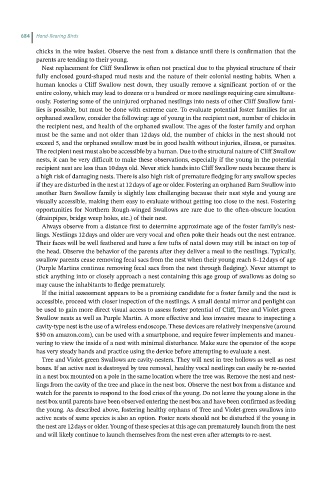Page 683 - Hand rearing birds second
P. 683
684 Hand-Rearing Birds
chicks in the wire basket. Observe the nest from a distance until there is confirmation that the
parents are tending to their young.
Nest replacement for Cliff Swallows is often not practical due to the physical structure of their
fully enclosed gourd‐shaped mud nests and the nature of their colonial nesting habits. When a
human knocks a Cliff Swallow nest down, they usually remove a significant portion of or the
entire colony, which may lead to dozens or a hundred or more nestlings requiring care simultane-
ously. Fostering some of the uninjured orphaned nestlings into nests of other Cliff Swallow fami-
lies is possible, but must be done with extreme care. To evaluate potential foster families for an
orphaned swallow, consider the following: age of young in the recipient nest, number of chicks in
the recipient nest, and health of the orphaned swallow. The ages of the foster family and orphan
must be the same and not older than 12 days old, the number of chicks in the nest should not
exceed 5, and the orphaned swallow must be in good health without injuries, illness, or parasites.
The recipient nest must also be accessible by a human. Due to the structural nature of Cliff Swallow
nests, it can be very difficult to make these observations, especially if the young in the potential
recipient nest are less than 10 days old. Never stick hands into Cliff Swallow nests because there is
a high risk of damaging nests. There is also high risk of premature fledging for any swallow species
if they are disturbed in the nest at 12 days of age or older. Fostering an orphaned Barn Swallow into
another Barn Swallow family is slightly less challenging because their nest style and young are
visually accessible, making them easy to evaluate without getting too close to the nest. Fostering
opportunities for Northern Rough‐winged Swallows are rare due to the often‐obscure location
(drainpipes, bridge weep holes, etc.) of their nest.
Always observe from a distance first to determine approximate age of the foster family’s nest-
lings. Nestlings 12 days and older are very vocal and often poke their heads out the nest entrance.
Their faces will be well feathered and have a few tufts of natal down may still be intact on top of
the head. Observe the behavior of the parents after they deliver a meal to the nestlings. Typically,
swallow parents cease removing fecal sacs from the nest when their young reach 8–12 days of age
(Purple Martins continue removing fecal sacs from the nest through fledging). Never attempt to
stick anything into or closely approach a nest containing this age group of swallows as doing so
may cause the inhabitants to fledge prematurely.
If the initial assessment appears to be a promising candidate for a foster family and the nest is
accessible, proceed with closer inspection of the nestlings. A small dental mirror and penlight can
be used to gain more direct visual access to assess foster potential of Cliff, Tree and Violet‐green
Swallow nests as well as Purple Martin. A more effective and less invasive means to inspecting a
cavity‐type nest is the use of a wireless endoscope. These devices are relatively inexpensive (around
$50 on amazon.com), can be used with a smartphone, and require fewer implements and maneu-
vering to view the inside of a nest with minimal disturbance. Make sure the operator of the scope
has very steady hands and practice using the device before attempting to evaluate a nest.
Tree and Violet‐green Swallows are cavity‐nesters. They will nest in tree hollows as well as nest
boxes. If an active nest is destroyed by tree removal, healthy vocal nestlings can easily be re‐nested
in a nest box mounted on a pole in the same location where the tree was. Remove the nest and nest-
lings from the cavity of the tree and place in the nest box. Observe the nest box from a distance and
watch for the parents to respond to the food cries of the young. Do not leave the young alone in the
nest box until parents have been observed entering the nest box and have been confirmed as feeding
the young. As described above, fostering healthy orphans of Tree and Violet‐green swallows into
active nests of same species is also an option. Foster nests should not be disturbed if the young in
the nest are 12 days or older. Young of these species at this age can prematurely launch from the nest
and will likely continue to launch themselves from the nest even after attempts to re‐nest.

